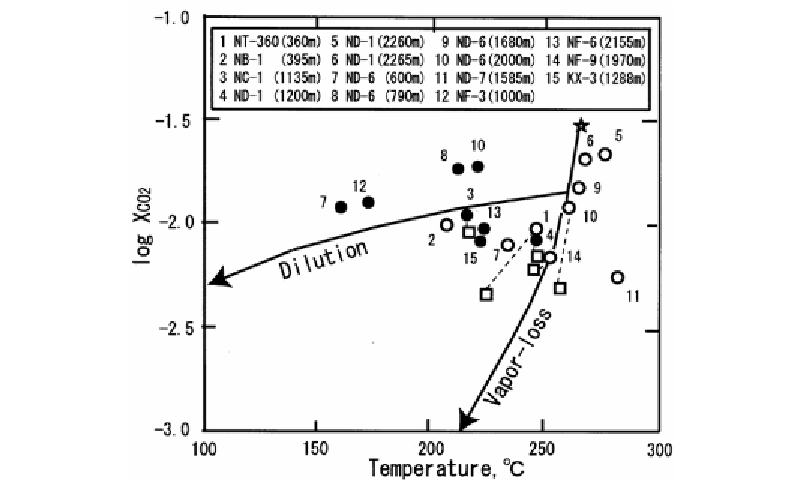Environmental Engineering Reference
In-Depth Information
Figure 11. Plot of log XCO2 versus temperature diagram for the inclusion fluids and the present
reservoir fluids at the initial stage of exploitation of the Mori geothermal field (Muramatsu et al., 1997).
Open and solid circles are quartz and anhydrite, respectively. Open rectangular shows the present
reservoir fluid at the initial stage of exploitation. The schematic vapor-loss curve was drawn through
calculation for a single step separation with adiabatic cooling by assuming the hypothetical initial
reservoir liquid composition of 3.2 mol% XCO2 at 265 ºC (open star). The schematic dilution curve is
the mixing line between the air-saturated groundwater at 20 ºC and the differential reservoir liquid at
260 ºC formed by boiling of the hypothetical initial reservoir liquid. Dotted line joins the present
reservoir fluid from the main inflow depth of five wells and the inclusion fluid in the analyzed samples
from the depth near the point.
On the contrary, log CO
2
value of the inclusion fluids in anhydrite has relatively narrow
ranges between -1.7 and -2.1, although fluid temperatures are widely distributed toward the
low temperature side (figure 11). It thus reveals that the inclusion fluids in anhydrite are
affected by dilution in addition to degassing. The difference of CO
2
contents in anhydrite
between 600 m depth and the two other deeper depths (790 and 2000m) in well ND-6 can be
explained by the degree of dilution. Additionally, the inclusion fluids in quartz from the
shallow depth of 395 m in well NB-1 might contain the most abundant groundwater of all
measured quartz samples (figure 11). As shown in figure 12, the inclusion fluids in anhydrite
are plotted on the higher CO
2
/N
2
ratio side of the vapor-loss curve. It might indicate that
anhydrite have trapped the reservoir fluids which are affected by degassing, in addition
dilution with air-saturated groundwater which has relatively low CO
2
/N
2
ratio and relatively
high CO
2
/CH
4
ratio. According to Arai (1994), anhydrite had started to form from
hydrothermal solution posterior to quartz, which has formed till after intrusion of hornblende
andesite. From these results and the mineral paragenesis, compared to the earlier quartz
formation stage, the reservoir fluid seems to be still affected by dilution with groundwater at
the later anhydrite formation stage. Moreover, the reservoir fluid seems to be affected by
dilution more at the shallower depths than at the deeper depths.

Search WWH ::

Custom Search